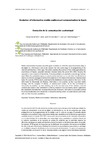Evolución de la comunicación audiovisual móvil informativa en España

View/
Use this link to cite
http://hdl.handle.net/2183/37975Collections
- Investigación (FCOM) [208]
Metadata
Show full item recordTitle
Evolución de la comunicación audiovisual móvil informativa en EspañaAlternative Title(s)
Evolution of informative mobile audiovisual communication in SpainDate
2024Citation
García-Torre, M., Formoso-Barro, M. J., & Videla-Rodríguez, J.-J. (2024). Evolución de la comunicación audiovisual móvil informativa en España. Observatorio (OBS*), 18(1), 171-188.
Abstract
[Resumen]: La comunicación móvil ha sido una de las grandes revoluciones a las que se han tenido que adaptar los medios de comunicación en la era de digital. La información es uno de los contenidos que toman protagonismo en las programaciones de los canales y por lo tanto en sus apps. El presente artículo profundiza en la evolución de las aplicaciones móviles para smartphone de las televisiones generalistas españolas durante el periodo 2012-2022 concretando este acercamiento en los contenidos informativos y en la interactividad. Se ha desarrollado una metodología mixta, cuantitativa y cualitativa. Dentro de la vertiente cuantitativa se ha realizado un análisis de contenido que ha permitido observar las diferentes estrategias en cuanto al tratamiento de la información en las televisiones objeto de estudio. Por ejemplo, RTVE apuesta de forma clara por la distribución de contenidos informativos en movilidad. Por otra parte, para Atresmedia y Mediaset la información no es prioritaria ya que centran su estrategia en movilidad, a excepción de laSexta, en los contenidos de entretenimiento. En cuanto a la apuesta por la interactividad, su evolución ha ido en descenso debido a que algunas de las televisiones analizadas hicieron en su día una apuesta clara por ofrecer herramientas interactivas creando aplicaciones concretas que la explotaban, pero a día de hoy están descatalogadas. En la actualidad, la información es un contenido secundario para las televisiones privadas y la interactividad se reduce a compartir contenidos por las redes sociales y correo electrónico siendo estas posibilidades muy poco interactivas. [Abstract]: Mobile communication has been one of the great revolutions to which the media have had to adapt in the digital era. Information is one of the contents that take centre stage in the programming of the channels and therefore in their apps. This article examines the evolution of the mobile applications for smartphones of Spanish generalist television channels during the period 2012-2022, focusing this approach on news content and interactivity. A mixed quantitative and qualitative methodology has been used. Within the quantitative aspect, a content analysis has been carried out which has allowed us to observe the different strategies in terms of the treatment of information in the television channels under study. For example, RTVE is clearly committed to the distribution of news content on the move. On the other hand, for Atresmedia and Mediaset, information is not a priority, as they focus their mobile strategy, with the exception of laSexta, on entertainment content. As for the commitment to interactivity, its evolution has been declining due to the fact that some of the television channels analysed once made a clear commitment to offering interactive tools by creating specific applications that exploited it, but today they have been discontinued. At present, information is a secondary content for private broadcasters and interactivity is reduced to sharing content via social networks and email, with very little interactive possibilities.
Keywords
Televisión
Comunicación móvil
Información
Interactividad
Television
Mobile communication
Information
Interactivity
Comunicación móvil
Información
Interactividad
Television
Mobile communication
Information
Interactivity
Editor version
Rights
Atribución-NoComercial 3.0 España Copyright © 2024 (García-Torre, Formoso-Barro, Videla-Rodríguez). Licensed under the Creative Commons AttributionNonCommercial Generic (cc by-nc). Available at http://obs.obercom.pt
ISSN
1646-5954






